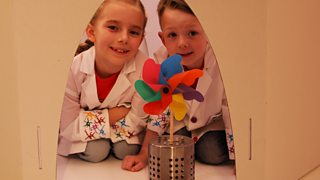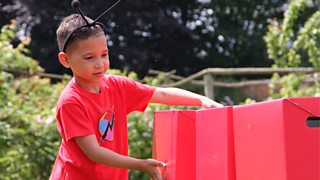What do children learn from building and construction in play?
Nina and The Neurons are back on CBeebies on Monday 7th September at 4:30pm. The new series - Get Building - explores exciting building and structures like skyscrapers, windmills and bridges.
We had a chat to the educational consultant on the series to find out what little ones will get out of the series...

Tell us a bit about yourself and how you’ve been involved in Nina and the Neurons: Get Building series?
I’m Janette Belcher and was the educational consultant on Nina and the Neurons: Get Building. My background lies in teaching – I was a primary teacher for 39 years, and Head teacher of a Glasgow nursery school for 24 years, so it’s safe to say I’m very interested in young children’s all-round development! For the series I worked closely with the production team, advising them on the different stages of development and the age-appropriateness of the scripts to ensure the programme is accessible and educational for the children watching.
Can you tell us a bit about the series?
The Get Building series introduces children to the concept of structures - both man-made and natural. It explains both the how (that’s the engineering and construction part) and why (the purpose) of structures, as well as aspects such as materials, ventilation, insulation and energy efficiency – all of the things that come together to make those structures work so well.
Sounds great! We all know that little ones love creating structures during play – why is it that children enjoy building things so much?
There are many reasons why children enjoy building things; the primary one is because a construction activity is an example of open-ended play – that is to say play with no specific set purpose or limitations that allows them to use the full force of their imaginations.
This allows them the opportunity to manipulate their environment in any way they want to, using materials to form a larger object from smaller ones. Building things increases their fine and large motor skills, hand-eye co-ordination and visual and spatial awareness; skills that are essential in Early Years development and form the foundations for things like writing.
Also, building something gives children immense satisfaction and a feeling of accomplishment, which is great for their confidence and sense of independence.

What does construction play teach little ones and why are these skills important in later life?
Construction play teaches children to problem-solve, connect socially, understand and be inquisitive in their play. They learn about the attributes of different materials, engage their curiosity and imagination, and experiment with applying concepts and exploring new ways to use physical materials. Children's active involvement in this way means the information they gather is first-hand and so much better remembered than information told by another.
Children’s language and literacy skills, mathematical skills and social and emotional skills are all developed through constructive play. The possibility that construction play provides for collaboration and teamwork - along with the other skills developed – contributes significantly to children’s socialisation as responsible citizens, effective contributors, successful learners and confident individuals.
Do children tend to build different structures depending on their stage of development and area of interest?
Definitely! Babies tend not to build as such but rather enjoy exploring materials through their senses. At around two years of age, children’s ‘’ (the way in which young children organise their thoughts) is about carrying and transporting materials.
Then at three, this progresses to stacking and bridging, which develops from age four to full enclosure (for example making a wall around something). At ages five to six, we see children starting to create buildings displaying pattern, symmetry and representation (that is to say building a hospital that looks like a hospital).

How can parents help to nurture and encourage the skills children gain from building?
Parents can support children by providing materials that are safe and accessible, both three- and two-dimensional, including recycled materials such as cartons and boxes. Parents can also give encouragement by having meaningful interactions with children: asking and answering open questions, helping record what they’ve done or said and photographing and video-recording their accomplishments. Most importantly, parents can nurture skills by taking a step back and letting children direct their own play. Allowing your child to decide what and how to make, build and construct encourages independent learning and play.